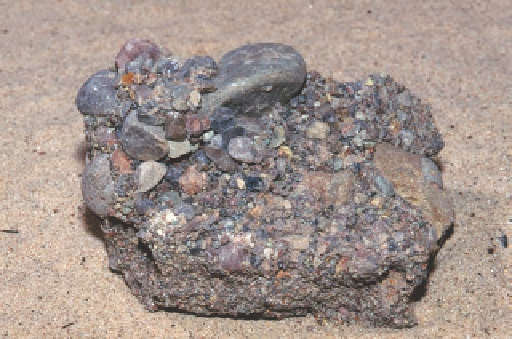Geoscience Reference
In-Depth Information
Clastic Sedimentary Rocks
Perhaps the easiest type of
sedimentary rock to understand is the category of clastic sedi-
mentary rocks. These rocks contain mineral fragments derived
from any of the three major rock groups that accumulate and
lithify. The most common minerals in clastic sedimentary rocks
are silicates, such as quartz and feldspar. Quartz is by far the
most important clastic sediment, primarily because it is hard
and very resistant to alteration. On the finer end of the textural
scale, clays can be weathered from feldspars and carried by
wind and water to some point where they are deposited.
Several types of clastic sedimentary rocks occur on Earth.
Sandstone
is created when individual sand grains are depos-
ited in thick layers by water along a beach or river, or by the
wind within dunes. This collection of sand grains then lithifies,
forming rock. When the sandstone also contains abundant
rocks and pebbles of various sizes, it is called
conglomerate
(Figure 12.10).
An excellent place to see beautiful sandstone outcrops is the
southwestern United States, with one of the best known rock bod-
ies being the Navajo Sandstone (Figure 12.11). The sediments
comprising this rock accumulated in sand dunes approximately
175 million years ago when the region was a desert and sand
was blown and deposited by the wind. Subsequently, the climate
became more humid, resulting in rivers that buried the dunes with
stream sediments. Still later, the region was covered by an ocean
that deposited tremendous quantities of marine sediments. As a
result of the compression and cementation of sands in the old
dunes, they gradually became rock.
Figure 12.11 The Navajo Sandstone.
Although it
may be hard to believe, this landscape was once an ac-
tive dune field in what is now Zion National Park, Utah.
You can tell that the sands accumulated in dunes be-
cause of the distinct bedding lines exposed in the out-
crop. Over a long period of time, the sand grains in the
dunes lithified to form this rock body.
In addition to the sedimentary rocks created from individual
sand grains, rocks can also be composed of finer grained silts
and clays. When fine grains dominate a sedimentary deposit, it
is referred to as
mud
. Silts and clays are easily suspended in and
transported by moving water. Thus, mud typically accumulates
in bodies of relatively still water, such as a coastal bay or lagoon
(Figure 12.12a). After they are deposited in these settings, they
lose a great deal of their original volume through compaction.
The origin of these rocks and their associated names are logically
based:
Siltstone
is dominated by silt-sized particles, and
clay-
stone
consists largely of clays. The most common fine-grained
sedimentary rock is
shale
, which is a claystone that easily breaks
into small flakes and has a platy appearance (Figure 12.12b).
Figure 12.10 Conglomerate rocks.
Conglomerate is a type
of rock consisting of large clasts contained within a matrix of
fine-grained particles. Note in this photo the mix of coarse
grains, cobbles, and fine sediments. Such a mix of particles
likely accumulated in a stream environment.
Sandstone
A sedimentary rock created when individual
sand grains are deposited in thick layers by wind or water
and lithify.
Shale
Sedimentary rock consisting of lithified clay-sized
sediments.
Sandstone that contains a wide variety of
Conglomerate
particle sizes.



